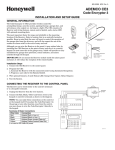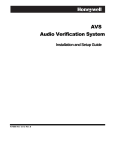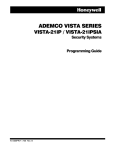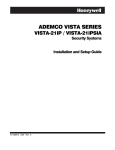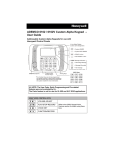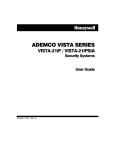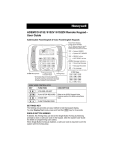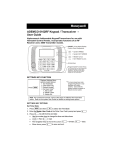Download ADEMCO 61 ADEMCO 6160PX INSTALLATION AND SETUP GUIDE
Transcript
ADEMCO 616 6160PX AlphaProx Keypad Keypad INSTALLATION AND SETUP GUIDE GENERAL INFORMATION The ADEMCO 6160PX is an addressable Remote Keypad with a built-in Proximity Reader, and is intended for use with ADEMCO control panels. Basic features of the Keypad • 2-line Alpha display • Backlit Display (programmable as permanent on some controls; see the control's instructions for details) • Continuously Backlit Keys for convenience • Programmable Function Keys • Built-in Sounder (speaker) • Arm/Disarm via Prox Tag • LED Indicators for Armed and Ready-To-Arm • Supervised by control panel (if supported) • Uses two keypad addresses Installation Notes • The Keypad can only be used on addressable systems and must be set for address 00-30 (16-23 for VISTA-15P / VISTA-20P and VISTA-21iP controls). • The Prox Reader uses an additional keypad address, which must be enabled at the control panel (see control panel installation instructions for allowable keypad addresses). • The partition used for the Keypad, Prox Reader, and user security code must be the same. • The Prox Tags will only arm and disarm one partition. The Prox Reader cannot be used to perform global arming operations. • For optimal performance, use only the Prox Tags provided. For additional Prox Tags, order PROXTG-BK (Black) or PROXTG-GY (Gray). MOUNTING AND WIRING The Keypad can be surface mounted directly to a drywall, or to a single- or double-gang electrical box. 1. Push the two case release snaps at the bottom of the Keypad with the blade of a medium screwdriver, then pull that side of the case back away. Insert the screwdriver in the side of the Keypad (between the front and back case) and gently twist to release the side locking tab. Repeat for the other side. Refer to Figure 1 for location of the case back release NOTE: snaps and locking tabs. TO REMOVE CASE BACK PUSH IN THE TWO MOUNTING 2. Route wiring from the control panel through the opening in SNAPS LOCATED ALONG THE BOTTOM OF THE KEYPAD AND LIFT UP. the case back. 3. Mount the case back to a wall or electrical box. 4. Wire directly from the Keypad’s terminal block to the RETAINING LOCKING SNAPS TAB terminal block on the control panel. (See Wiring Table below). Connect only the red and black Aux. Power Figure 1. Removing the Case Back connections at this time. ARMED Do not connect the ECP Data In or Data Out until directed to do so. If the keypad’s Prox Reader detects the presence of ECP Data In and Out connections during address programming mode, it will exit to “normal” mode. NOTE: No more than one wire per terminal may be connected. If daisy-chained configuration is required, pigtail wires together so that only one wire is terminated under the screw. Use 16-24 AWG wire only! 6150-006-V0 READY Wiring Table Keypad Control Panel Wire Color Data In Green – – Aux Pwr (GND) Black + + Aux. Pwr Red Data Out Yellow ▼Y See the control panel’s Installation and Setup Guide for more complete details. ▲G 5. Reattach the Keypad to its case back. 6. If the Keypad and Prox Reader addresses have not yet been programmed, refer to the Setting the Keypad and Prox Reader Addresses section and set the two addresses. 7. After the Keypad and Prox Reader addresses have been programmed, remove the Keypad from its back plate again (see step 1 above) and connect the green and yellow (data in/data out) wires from the control. 8. Reattach the Keypad to its case back. SUMMARY OF PROGRAMMING STEPS 1. Connect only the red and black wires to the Keypad. 2. Program the Keypad address (01-31). 3. Press * to save. 4. “Prox Addr? XX” displays. Enter an unused keypad address for the Prox Reader. 5. Press * to save. 6. Power down the panel. 7. Connect the green and yellow wires and complete the installation. 8. Power up the panel. 9. In control panel programming, configure the programmed Prox Reader address as a keypad. a. If using a Vista-128, Vista-50 or like panels, go to device programming and program the Prox Address as an “Alpha Console.” b. If using a VISTA-15P/VISTA-20P, use an address between 17 and 23. Go to location *190 to *196 and enter the partition in which the Keypad is being used. 10. Exit control panel programming mode. 11. Enroll the Prox Tag by programming a new “User” code with the four-digit serial number located on the tag’s packaging. SETTING THE KEYPAD AND PROX READER ADDRESSES The Keypad requires two unique device addresses: a Keypad address and a Prox Reader address. Addresses range from 00-30 (default address is 31 and must be changed to an appropriate address). To initially set the addresses, make sure that only the red and black wires are connected to the Keypad, then follow the steps below for Keypad Address Mode and Prox Reader Address Mode. When both the Keypad address and Prox Reader address have been programmed, power down the control and complete the wiring connections (see step 7 in Mounting and Wiring section). After the installation is completed, only the keypad address can be changed. NOTES: • The Prox Reader address can be set only when the green and yellow data wires are disconnected. • The keypad will not enter address mode if the panel to which it is connected is in programming mode. • If 10 seconds have passed with no key entry, the keypad automatically exits address mode. You must power down, power up and start address mode again. • Defaults: Keypad address = 31; Prox Reader address = 23 Keypad Address Mode 1. Enter keypad address mode: Power up the Keypad. Immediately† press and hold down the [1] and [3] keys at the same time for 3 seconds. If unable to enter address mode, power up and try again. The current keypad address is displayed, and the cursor will be under the "tens" digit. † If only the red and black wires are connected, press within 5 seconds of power-up. If more than 5 seconds elapses before pressing the [1] and [3] keys, the Keypad automatically enters Prox Reader Address Mode. After all wires are connected, press and hold the [1] and [3] keys within 60 seconds of power up. 2. Enter the keypad's address: Enter the proper "tens" digit of the keypad's address. The cursor will move to the "ones" digit position. Enter the proper "ones" digit of the keypad's address. 3. Press [✻] to save the displayed address. • If only the red and black wires are connected, the Keypad now enters Prox Reader address mode. • If all wiring is connected, the system exits address mode. Prox Reader Address Mode NOTE: This mode can be entered only if the green and yellow data wires are disconnected. 1. After exiting Keypad Address mode, the Prox Reader begins communicating with the Keypad, and the Keypad displays “Prox Addr? XX” on the first line. 1. XX = the current ECP Address. The Prox Reader address cannot be the same as the Keypad address. Select an address between 01 and 30 (default = address 23.) 2. Make sure you enable the Prox Reader address as a keypad in the control panel. 2. Enter the appropriate address: Enter the proper "tens" digit of the address. The cursor moves to the "ones" digit position. Enter the proper "ones" digit of the address. 3. Press the [*] key to save the entry. The Keypad beeps three times confirming the address is accepted, and the first digit of the address flashes. You can reenter the address if needed. 4. Power down the Keypad and remove the case back. 5. Refer to step 7 of the Mounting and Wiring section and complete the green and yellow wiring connections. VIEWING THE KEYPAD ADDRESS During normal operation, press and hold down the [1] and [3] keys at the same time for about 3 seconds. The current keypad address is displayed. No key entry is allowed. Press any key to exit or wait 10 seconds to exit viewing mode. ENROLLING PROX TAGS Each Prox Tag is enrolled as a “User” in the alarm system. When enrolling the Tags, the last four digits of the Tag’s serial number is used as the User Code. Refer to the control’s User Guide for instructions on programming user codes. When programming is complete, test the system to ensure that each Prox Tag arms and disarms the system as specified. Swiping a Prox Tag when the system is in programming mode may cause programming fields to receive invalid entries. KEYPAD OPERATION For detailed system operating instructions, refer to the User Guide for the control panel used with this keypad. Prox Tag Operation Prox tags are used to alternately arm and disarm the system. Presenting a prox tag is functionally equivalent to entering a 4-digit security code. To arm or disarm the system, present the prox tag at the location of the Proximity Label (bulls eye) on the front of the keypad. The system beeps to confirm that it is has been armed or disarmed. Arming (if system is disarmed): System arms in the AWAY mode. Disarming (if system is armed): System disarms and, if an alarm occurred, alarm sounding is silenced. Programmable Function Keys The keypad features function keys that may be programmed for panic alarms or other special functions such as macros. See the control's instructions for details. Function Keys A B C D LCD DISPLAY SPEAKER ARMED A 1 OFF 2 AWAY 3 STAY READY B 4 MAX 5 TEST 6 BYPASS C 7 INSTANT 8 CODE 9 CHIME READY 0 LEDS PRESENT PROX TAG HERE D # FUNCTION KEYS 6160PX-001-V0 • Function keys must be held down for at least 2 seconds to activate the programmed function. • If functions other than panics are assigned to the programmable function keys, programmed panics must be initiated by pressing the programmed key pair. Equivalent Key Pairs [1] and [∗] [∗] and [#] [3] and [#] NONE Function Key Labels A set of adhesive-backed labels with some typical function symbols (i.e., fire, police, personal emergency, etc.) is provided. These labels can be placed on or next to the keys to identify each key's function for the end user (as determined by the control panel's capability and programming; see the control's instructions). Keypad Displays and LEDs The Keypad provides a two-line alphanumeric display and custom zone descriptors. The table identifies the Keypad’s LEDs and associated functions. LED ARMED READY Function Lights red when the system is armed in any mode. Lights green when the system is "ready" to be armed. SPECIFICATIONS Physical: Displays: Sounder: Voltage: Current: 5-5/16"H x 7-3/8"W x 1-3/16"D 2 x 16 alpha-numeric supertwist LCD, backlit Speaker (fire alarm is loud, pulsing single tone; burglary alarm is loud, continuous, dual tone) 12VDC (power-limited) 165mA (ARMED LED lit, LCD backlight and sounder on), reduces to 40mA when panel is operating in standby mode (backlight off) NFPA-72 Compliant REFER TO INSTALLATION INSTRUCTIONS FOR THE CONTROL PANEL WITH WHICH THIS DEVICE IS USED FOR WARRANTY INFORMATION AND LIMITATIONS OF THE ENTIRE ALARM SYSTEM. FEDERAL COMMUNICATIONS COMMISSION (FCC) PART 15 STATEMENTS The user shall not make any changes or modifications to the equipment unless authorized by the Installation Instructions or User's Manual. Unauthorized changes or modifications could void the user's authority to operate the equipment. CLASS B DIGITAL DEVICE STATEMENT NOTE: This equipment has been tested and found to comply with the limits for a Class B digital device, pursuant to part 15 of the FCC Rules. These limits are designed to provide reasonable protection against harmful interference in a residential installation. This equipment generates, uses and can radiate radio frequency energy and, if not installed and used in accordance with the instructions, may cause harmful interference to radio communications. However, there is no guarantee that interference will not occur in a particular installation. If this equipment does cause harmful interference to radio or television reception, which can be determined by turning the equipment off and on, the user is encouraged to try to correct the interference by one or more of the following measures: • Reorient or relocate the receiving antenna. • Increase the separation between the equipment and receiver. • Connect the equipment into an outlet on a circuit different from that to which the receiver is connected. • Consult the dealer or an experienced radio/TV technician for help. INDUSTRY CANADA (IC) STATEMENTS This device complies with RSS210 of Industry Canada. Operation is subject to the following two conditions: (1) This device may not cause harmful interference, and (2) This device must accept any interference received, including interference that may cause undesired operation. This Class B digital apparatus complies with Canadian ICES-003. Cet appareil numérique de la classe B est conforme à la norme NMB-003 du Canada. Prox Tag User Log Use this form to keep a record of system users and their associated Prox Tag. USER NAME Ê800-04917V1YŠ 800-04917V1 4/10 Rev. A USER NUMBER AUTHORITY LEVEL 4-DIGIT TAG NUMBER (Tag’s User Code) 2 Corporate Center Drive, Suite 100 P.O. Box 9040, Melville, NY 11747 Copyright © 2009 Honeywell International Inc. www.honeywell.com/security





